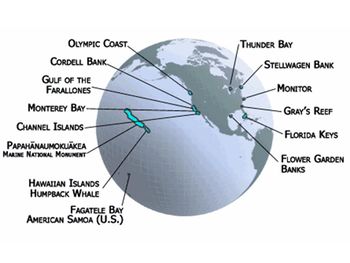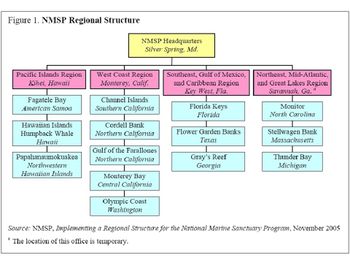US National Marine Sanctuaries
The U.S. National Marine Sanctuaries (NMS) system is the federal program that designates marine protected areas to protect and enhance biodiversity, ecological integrity and cultural assets of national significance. There are 13 national marine sanctuaries and one national monument covering a total of 150,000 square miles marine waters. The resources protected by sanctuaries range from coral reef and kelp ecosystems to shipwrecks. Established in 1972, the system has worked to expand its coverage across the country and receive sufficient funding for the program.
Contents
History
Congress established the Stratton Commission in 1966 to recommend a new approach to ocean and coastal resources management. The commission released its recommendations in 1969, including a call for a new federal agency for ocean management. That same year, a major oil spill off the California coast near Santa Barbara attracted the nation’s attention and underscored the need for improved ocean management.
Guided by the Stratton Commission and motivated by the Santa Barbara oil spill, Congress passed several environmental laws in the early 1970s including the Marine Protection, Research, and Sanctuaries Act in 1972. Title III of that Act created the National Marine Sanctuaries Program to protect marine parks—a hundred years after the establishment of the terrestrial National Park System. Title III of the Act permits NOAA to:
“…designate as marine sanctuaries those areas of the oceans, coastal, and other waters, as far seaward as the outer edge of the Continental Shelf…which the Secretary of Commerce determines necessary for the purpose of preserving or restoring such areas for their conservation, recreational, ecological, or esthetic values [1].”
The first national marine sanctuary established in 1975 was the USS Monitor, a shipwreck off the North Carolina coast. Later that same year, Key Largo National Marine Sanctuary off the coast of Florida was designated. The most recent addition came in 2006 with the establishment of the Papahānaumokuākea Marine National Monument (originally called the Northwestern Hawaiian Islands Marine National Monument), the largest single conservation area in the country.
Evolution of the Program
The Marine Protection, Research, and Sanctuaries Act later became the National Marine Sanctuaries Act (NMSA). It is reauthorized every four to five years. The first major amendments occurred in 1980 stipulating that the Coast Guard shall provide the enforcement needed to support the sanctuaries. Further amendments came in 1984 to clarify certain issues including public consultations, documenting present and potential uses of the protected areas, and to conduct research and educational programs in sanctuaries. The next round of amendments passed in 1988 gave the NMS authority to permit commercial operations to recover the economic-values in using the resources. Also, vessel groundings or pollution that destroyed sanctuary resources would be liable for response and clean-up costs. Fines collected would be deposited in a specific sanctuary account to be used for conservation. Several changes were made in 1992 including the establishment of citizen advisory councils to assist in planning and management of sanctuaries. The final major amendments occurred in 2000 with the mandate to create a coherent system of sanctuaries. While at the same time, Congress prohibited any further designations until NOAA could demonstrate they could provide adequate resources to manage the existing set of sanctuaries.
Governance Framework of the Program
The National Oceanic and Atmospheric Administration (within the Department of Commerce) Office of National Marine Sanctuaries manages the NMSP and is required to balance conservation with compatible commercial and recreational activities.
There are three ways to designate a marine area for protection. Under the 1972 Marine Protection, Research and Sanctuaries Act, the Secretary of the Department of Commerce and the Congress are authorized to designate discrete areas. The President also has the authority to establish Marine National Monuments under the Antiquities Act. State Governors have the authority to dispute any designations.
The NMSP is guided by a national strategic plan that sets out seven goals and 19 performance measures. These guide the development of individual sanctuary management plans.
| Outcome Goals | Activity Goals |
|---|---|
| Protect the sites | Build a nationwide system of sanctuaries |
| Facilitate human uses that are compatible with protection | Build the operational capability and infrastructure to manage sites effectively |
| Enhance nationwide public awareness, understanding, and appreciation | Work internationally to improve management and protection |
| Enhance scientific understanding to support management of the sites and marine ecosystems |
All sanctuaries are supported by sanctuary advisory councils (SACs) that review and update sanctuary management plans and develop issue-specific action plans. SACs are composed of local community groups, industry representatives and government agencies.
All sanctuaries are required to produce management plans with the SACs. The plans summarize existing programs and regulations, articulate goals and priorities, and guide management planning and decision-making. Most NMS management plans are over 10 years old.
In 2005, the NMSP decentralized the structure to advance coordination between sanctuaries. Four regional offices were established to link staff with other regional programs and partners.
Complementary to the NMSP is the National Park Service (NPS). There are over 40 National Parks that encompass marine areas totaling 3 million acres of ocean and coastal waters and more than 4,000 miles of coastline within their boundaries.
Key Tools
The NMSP relies on an assortment of regulatory and compliance tools to achieve its goals. At the core of each tool is the sanctuaries’ collaborative approach to engaging stakeholders in planning and implementation activities.
Sanctuary regulations identify specific activities that are allowed as well as zoning boundaries. While the NMSP has some regulatory powers, a major issue is the relationship between a sanctuary and fisheries management. This has been an area of much debate with the National Marine Fisheries Service, the regional Fishery Management Councils and the fishing industry. This issue was central to the revision of the Channel Islands Sanctuary in which a network of no-take marine reserves were established within the sanctuary (see CINMS case study).
Sanctuaries also use a permit system to allow selective commercial activities that are complementary to the conservation goals. Policies are often developed for specific conservation issues such as invasive species.
Recognizing their limited budgets and staff resources, the NMSP has developed an extensive public education program to increase understanding, awareness and stewardship of marine resources. The enforcement program also emphasizes stakeholder education.
Effectiveness
Several evaluations of the NMSP’s management effectiveness have been conducted over the years. The National Academy of Public Administration (NAPA) identified many successes in 2000 and encouraged the NMSP to focus on results as opposed to process, and to embrace the value and strength of SACs. NAPA released a second report in 2006 citing significant advances in the system and engaging stakeholders in the management process. NMSP is seen as a model for ecosystem-based management as advocated for by two national ocean commissions. In 2008, the Office of Inspector General [2] concluded that the NMSP is making progress towards long-term protection of marine ecosystems and cultural resources. The program has become more of a national system of protected areas as called for by Congress through consistent performance measures, annual operating plans, system-wide monitoring reports and the regional management structure. Areas in need of improvement include the enforcement of sanctuary regulations.
The MPA Center [3] produced lessons learned on the MPA designation process. Highlights of their lessons include the need to understand the social and political history of a place before embarking on a collaborative planning process.
See also
Internal Links
- Channel Islands National Marine Sanctuary – Case Study
- US Coastal Zone Management Program
- Coastal Barrier Resources System
- Overview of Coastal Habitat Protection and Restoration in the United States
- Essential Fish Habitat
- Chesepeake Bay Program
- Clean Water Act
- US National Estuary Program
- US National Estuarine Research Reserve System
- US National Wildlife Refuge System
- Rhode Island Salt Pond Special Area Management Plan – Case Study
- US Sea Grant College Program
- Tampa Bay Estuary Program
- US Army Corps of Engineers’ Coastal Programs
External Links
- National Marine Sanctuary Program http://sanctuaries.noaa.gov
- National Marine Sanctuaries Act http://sanctuaries.noaa.gov/library/National/NMSA.pdf
- National Marine Sanctuary Foundation http://nmsfocean.org/
- OceansLive http://www.oceanslive.org/
- Marine Protected Areas Center http://mpa.gov/
- National Park Service http://www.nps.gov/
Further Reading
- Final Inspection Report by the Office of Inspector General http://www.oig.doc.gov/oig/reports/2008/IPE-18591.pdf
- National Academy of Public Administration http://www.napawash.org/Marine.Sanctuary.pdf
- Owen, Dave. The Disappointing History of the National Marine Sanctuaries Act. NYU Environmental Law Journal, Vol. 11, No. 3, 2003 Available at SSRN: http://ssrn.com/abstract=1009269
- Warburg, Philip and Priscilla Brooks. Stellwagen Bank's unmet mission. May 16, 2008. Boston Globe. http://www.boston.com/bostonglobe/editorial_opinion/oped/articles/2008/05/16/stellwagen_banks_unmet_mission/
- Morin, Tracey. “Sanctuary Advisory Councils: Involving the Public in the National Marine Sanctuary Program.” Coastal Management 29 (2001): 327–339.
- Helvey, Mark. “Seeking Consensus on Designing Marine Protected Areas: Keeping the Fishing Community Engaged.” Coastal Management 32 (2004): 173-190.
- Chandler, William J., and Hannah Gillelan. The Makings of the National Marine Sanctuary Act: A Legislative History and Analysis. Marine Conservation Biology Institute, 2005.
- Chen, Kathy, Camille Kustin, Joshua Kweller, Carolyn Segalini, and Julia Wondolleck. “Sanctuary Advisory Councils: A Study in Collaborative Resource Management.” University of Michigan School of Natural Resources and Environment, 2006.
References
- ↑ 1.0 1.1 www.noaa.gov
- ↑ Final Inspection Report by the Office of Inspector General http://www.oig.doc.gov/oig/reports/2008/IPE-18591.pdf
- ↑ MPA Center. 2004. Lessons Learned from Recent Marine Protected Area Designations in the United States http://mpa.gov/helpful_resources/lessons_learned.html
Please note that others may also have edited the contents of this article.
|

